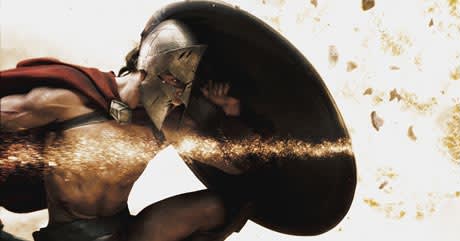After a rather tumultuous relationship with Hollywood in the past (Miller wrote the original screenplays that were heavily, um, altered for Robocop 2 and 3), legendary comic book guru Frank Millers star has been on the rise, cinematically speaking, in recent years.
First there was Robert Rodriguezs near-note perfect translation to the big screen of Millers Sin City, which was so faithful to the series (and to its strengths and weaknesses), and relied so heavily on Millers input/approval, that Miller garnered himself a co-director credit. And, to tide Miller fanatics over until Sin City 2, theres now 300, Zack Snyders (the Dawn of the Dead remake) adaptation of Millers beautiful, ruthless graphic novel.
300 the film (as well as the book) tells the rather simplified but true tale of the Battle of Thermopylae in 480 B.C., where a vastly outnumbered group of 300 Spartans and assembled allies led by King Leonidas of Sparta fought a desperate last stand against a vastly superior invading Persian army under the command of Xerxes. (Both versions cut out the main reason for this, however to buy time to gather Greek forces for a decisive navel battle and instead attribute it to "honour and a Spartan refusal to capitulate.)
Where 300 the book and 300 the film differ isnt so much in visual aesthetic (like Rodriguez, Snyder has attempted to translate Millers style, here more colour-oriented than the black and white dystopia of Sin City, to the big screen) but in what has been added and subtracted. Namely, the unrelenting harshness of Millers Spartans has been softened for the big screen, cracking jokes like they were all Gimli towards the end of The Lord of the Rings saga, while a Rome-like political machinations sub(par)-plot with Queen Gorgo has been added, which frankly rings false. Granted, Millers book is sparse concerning both plot and character development (besides the king, played well here by Gerard Butler), and there was a need to flush the tale out for the big screen, but it contradicts the "Spartans dont back down or compromise mentality greatly. However, apparently all the changes were Miller-approved.
As well, while the hyper-stylised, comic book/dream world look works, at times (and allows for, um, visual exaggerations), it also hinders, especially in a world where viewers are used to seeing large-scale ancient battles that attempt some sort of accuracy and realism: The Lord of the Rings, Rome, Braveheart, Gladiator, Alexander, Kingdom of Heaven, etc. Sure, the slow-mo kills look awesome, as do the flapping capes and glinting helmets, and some of the creatures/enemies are CGImpressive, but the battles become repetitive and muddled, and it seems the movie should have been called 30, not 300, as thats about as many Spartans as you ever see on screen at one time.
A lot is being made on-line about whether or not 300 is a political allegory regarding the current President of the U.S. if Bush is Xerxes (invading Iraq) or Leonidas (fighting a desperate last stand against the U.S.s enemies) and a case could be made for either depending on allegiances and conspiracy theories. But since the book was written years ago, and Snyder is hardly one to comment on political climates or culture (remember, he stripped his Dawn remake of the originals consumer critique), that seems highly doubtful.
Despite its shortcomings (remember, what makes an awesome graphic novel doesnt always translate to the screen), 300 is still, for the most part, an enjoyable kill-crazy rampage (although its no Sin City). In fact, depending on your appreciation of male semi-nudity, arterial blood sprays and red capes, 300 might just become your favourite movie ever.
(Warner)First there was Robert Rodriguezs near-note perfect translation to the big screen of Millers Sin City, which was so faithful to the series (and to its strengths and weaknesses), and relied so heavily on Millers input/approval, that Miller garnered himself a co-director credit. And, to tide Miller fanatics over until Sin City 2, theres now 300, Zack Snyders (the Dawn of the Dead remake) adaptation of Millers beautiful, ruthless graphic novel.
300 the film (as well as the book) tells the rather simplified but true tale of the Battle of Thermopylae in 480 B.C., where a vastly outnumbered group of 300 Spartans and assembled allies led by King Leonidas of Sparta fought a desperate last stand against a vastly superior invading Persian army under the command of Xerxes. (Both versions cut out the main reason for this, however to buy time to gather Greek forces for a decisive navel battle and instead attribute it to "honour and a Spartan refusal to capitulate.)
Where 300 the book and 300 the film differ isnt so much in visual aesthetic (like Rodriguez, Snyder has attempted to translate Millers style, here more colour-oriented than the black and white dystopia of Sin City, to the big screen) but in what has been added and subtracted. Namely, the unrelenting harshness of Millers Spartans has been softened for the big screen, cracking jokes like they were all Gimli towards the end of The Lord of the Rings saga, while a Rome-like political machinations sub(par)-plot with Queen Gorgo has been added, which frankly rings false. Granted, Millers book is sparse concerning both plot and character development (besides the king, played well here by Gerard Butler), and there was a need to flush the tale out for the big screen, but it contradicts the "Spartans dont back down or compromise mentality greatly. However, apparently all the changes were Miller-approved.
As well, while the hyper-stylised, comic book/dream world look works, at times (and allows for, um, visual exaggerations), it also hinders, especially in a world where viewers are used to seeing large-scale ancient battles that attempt some sort of accuracy and realism: The Lord of the Rings, Rome, Braveheart, Gladiator, Alexander, Kingdom of Heaven, etc. Sure, the slow-mo kills look awesome, as do the flapping capes and glinting helmets, and some of the creatures/enemies are CGImpressive, but the battles become repetitive and muddled, and it seems the movie should have been called 30, not 300, as thats about as many Spartans as you ever see on screen at one time.
A lot is being made on-line about whether or not 300 is a political allegory regarding the current President of the U.S. if Bush is Xerxes (invading Iraq) or Leonidas (fighting a desperate last stand against the U.S.s enemies) and a case could be made for either depending on allegiances and conspiracy theories. But since the book was written years ago, and Snyder is hardly one to comment on political climates or culture (remember, he stripped his Dawn remake of the originals consumer critique), that seems highly doubtful.
Despite its shortcomings (remember, what makes an awesome graphic novel doesnt always translate to the screen), 300 is still, for the most part, an enjoyable kill-crazy rampage (although its no Sin City). In fact, depending on your appreciation of male semi-nudity, arterial blood sprays and red capes, 300 might just become your favourite movie ever.




